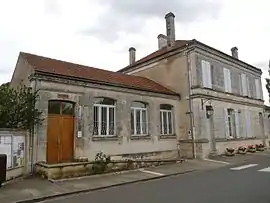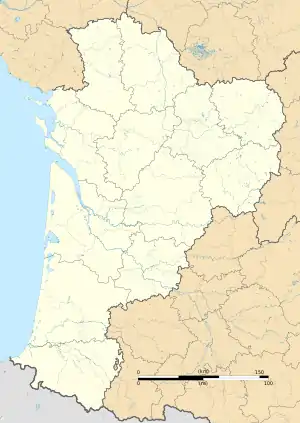Épenède | |
|---|---|
 The town hall in Épenède | |
Location of Épenède | |
 Épenède  Épenède | |
| Coordinates: 46°03′52″N 0°32′17″E / 46.0644°N 0.5381°E | |
| Country | France |
| Region | Nouvelle-Aquitaine |
| Department | Charente |
| Arrondissement | Confolens |
| Canton | Charente-Vienne |
| Intercommunality | Charente Limousine |
| Government | |
| • Mayor (2020–2026) | Philippe Denimal[1] |
| Area 1 | 15.62 km2 (6.03 sq mi) |
| Population | 176 |
| • Density | 11/km2 (29/sq mi) |
| Time zone | UTC+01:00 (CET) |
| • Summer (DST) | UTC+02:00 (CEST) |
| INSEE/Postal code | 16128 /16490 |
| Elevation | 144–194 m (472–636 ft) (avg. 192 m or 630 ft) |
| 1 French Land Register data, which excludes lakes, ponds, glaciers > 1 km2 (0.386 sq mi or 247 acres) and river estuaries. | |
Épenède (French pronunciation: [epnɛd]; Occitan: Espeneda) is a commune in the Charente department in southwestern France.
Épenède, of which the Latin spina would mean thorn shrub, is bordered to the north by the department of Vienne and to the southwest by the valley of the river Transon. The village is situated on the dividing line of the waters of the Charente and the Vienne. The parish of Épenède was a dependant of the vast domains of the Benedictine abbey at nearby Charroux and in the diocese of Poitiers.
Population
| Year | Pop. | ±% p.a. |
|---|---|---|
| 1968 | 323 | — |
| 1975 | 269 | −2.58% |
| 1982 | 256 | −0.71% |
| 1990 | 242 | −0.70% |
| 1999 | 209 | −1.62% |
| 2009 | 208 | −0.05% |
| 2014 | 218 | +0.94% |
| 2020 | 169 | −4.15% |
| Source: INSEE[3] | ||
Sights
The Holy Church of St. Hilaire is 12th century and is of Limousin style (except the steeple bell tower which is more recent). This structure was burned at the time of the Wars of Religion. The capitals of the four spans of the nave are ancient, and one of them represents a monster holding in its claws a human head that it is about to devour. Many water sources or fountains "miraculous" sprinkle the commune.
See also
References
- ↑ "Répertoire national des élus: les maires" (in French). data.gouv.fr, Plateforme ouverte des données publiques françaises. 13 September 2022.
- ↑ "Populations légales 2021". The National Institute of Statistics and Economic Studies. 28 December 2023.
- ↑ Population en historique depuis 1968, INSEE